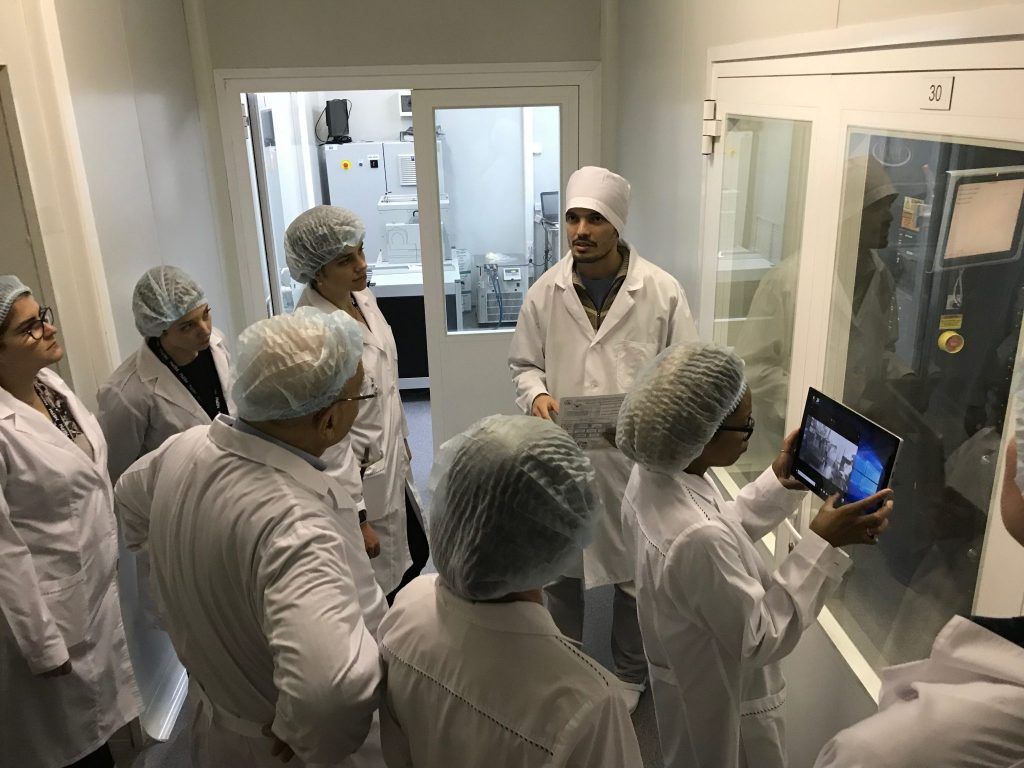Resolving safety and security concerns about nuclear power
By Roman Bobrov, Julia Diamond, Khalit Shemshedinov | June 20, 2019
 On a tour of the Moscow Engineering Physics Institute (MEPhI).
On a tour of the Moscow Engineering Physics Institute (MEPhI).
Safety and security concerns about nuclear power reactors, along with high capital costs and public opposition, have played a significant role in hindering the expansion of nuclear power. While major accidents such as Three Mile Island, Chernobyl, and Fukushima have increased global awareness of safety concerns, the September 11, 2001, terrorist attacks in the United States heightened concerns about possible security threats to the nuclear power industry.
Whether safety and security questions will prevent a significant expansion of global nuclear power in the future—and a corresponding reduction in climate-altering pollution—depends largely on how governments and the nuclear industry respond. To confront these challenges, countries should change the way nuclear reactors are constructed and operated—continuing some already-begun modifications and improvements to existing reactors in the short term, and switching to new, improved designs in the longer term. Although a series of comprehensive best practices for addressing safety and security concerns in the nuclear power industry already exists, some measures will necessarily differ from country to country.
Safety concerns. The main safety concern for nuclear power plants is a major accident. Most recently, the 2011 Fukushima accident led to drastic changes in public sentiment toward nuclear power in some countries (for example, Japan had massive anti-nuclear protests, and Germany decided to phase out nuclear power), and to strengthened safety regulation requirements in a number of countries, including the United States and France. Belgium and Sweden altered the safety measures of existing plants based on the results of stress tests, while the United States conducted “walk-throughs” to identify needed safety enhancements. Canada focused on increasing safety at sites with multiple reactors.
After the 1986 Chernobyl accident, Russia made important design modifications to its RBMK reactors. Both then and more recently (in order to grant life extensions), older reactors in the country received safety system upgrades. Russia stopped building RBMK reactors and switched to pressurized water reactors (VVER in Russian terminology) similar to US designs. As a major nuclear technology exporter, Russia has a significant economic interest in assuring its reactors operate in accordance with domestic and internationally accepted safety standards.
In the United States, the response to the Three Mile Island accident in 1979 led to increased public concern about nuclear power. The implementation of more-stringent safety regulations and better plant designs significantly increased plant construction times and capital costs. These and other factors, including regulatory uncertainty, contributed to the virtual abandonment of nuclear power in the United States.
Safety solutions. After the Fukushima accident, some countries tightened their safety regulations (Japan even temporarily stopped operation of all its nuclear reactors), but plant commissioning still continues. The US Nuclear Regulatory Commission reported that just over one third of currently operating nuclear power reactors have completed all mitigation actions required in response to the lessons learned from the Fukushima accident.
Despite both old and new safety challenges, following through with the licensing and construction of pre-approved advanced reactor designs—combined with implementing operational practices aimed at lowering operating costs—and offering federal or state financial incentive programs for nuclear energy appear to be effective means of meeting the challenges posed by safety concerns. Generation III and IV reactor designs, based on passive safety principles, are planned to meet newer, heightened safety requirements while also focusing on decreasing capital costs.
The advent of Generation III reactor designs has led to new design certification in the United States, with the indigenous Westinghouse AP1000 (Generation III+) now available for construction in the United States and abroad. Russia is developing new fast reactors based on a closed fuel cycle; they are expected to reduce the volume of spent nuclear fuel and radioactive wastes generated.
The new designs incorporate passive safety measures (relying on physical phenomena like convection or gravity instead of operator actions to cool the core in a serious accident); high-temperature-resistant materials to prevent core meltdowns; seismic protections; and simpler layouts (for example, improved access to important valves and wider corridors for equipment transfers). These simpler designs, along with modular structures aimed at decreasing construction time, are expected to reduce capital costs. Collocating more than one reactor at a given plant site also decreases operation costs, because the reactors can share such things as cooling systems, fire equipment, and spare parts.
As a more far-reaching step, standardizing nuclear reactor designs internationally would allow for quicker introduction of inherently safer designs. Work by the Multinational Design Evaluation Program, launched by the United States and France in 2006 to develop multinational standards for Generation IV reactor designs, provides hope that this might become a reality once such designs enter commercial operation.
While collaborative work through international initiatives and organizations like the International Atomic Energy Agency (IAEA) have helped generate globally accepted best practices for safety, countries differ with respect to their histories with, and public acceptance of, nuclear energy. Countries with greater experience in nuclear energy programs—such as the United States, Russia, and France—understand the type of safety measures that should be incorporated into current and future reactor designs. On the other hand, newcomer countries—for example, in West Africa and the Middle East—lack the safety know-how of more experienced countries.
We commend the practices of the French and American governments to make available the expertise in their regulatory and technical agencies, such as France’s Nuclear Safety Agency and the US Energy Department, to serve in advisory roles to countries contemplating the introduction of nuclear power. Likewise, international organizations should continue to lend their nuclear safety expertise to newcomer countries. Beyond governmental programs, self-help organizations such as the World Association of Nuclear Plant Operators can review and comment on the nuclear safety practices and cultures of their member utilities.
Security concerns. According to the IAEA, security concerns in the nuclear industry comprise “criminal or intentional unauthorized acts involving or directed at nuclear material, other radioactive material, associated facilities, or associated activities,” including nuclear terrorism. Examples of these acts include forced intrusions—such as with a vehicle carrying explosives, an attack involving missiles or aircraft, an attack initiated by someone inside the nuclear power plant, or a combination of attack types.
At reactor facilities, terrorists may target systems responsible for core functioning and integrity. For nuclear power plant engineers, preventing the uncontrolled release of radioactive material after a terrorist attack or act of sabotage, and achieving and maintaining a safe shutdown condition, are the primary goals. The terrorist attacks in the United States on September 11, 2001, spurred global action on security threats to nuclear power plants.
There have been security breaches at nuclear facilities, but because these never led to drastic damage or radiological emissions on a scale similar to the consequences of the world’s three major nuclear accidents, security concerns did not lead to global setbacks for the nuclear industry. That said, security is widely considered to be a larger concern for the nuclear power industry than for other energy industries because of the potential damage to human health and the environment associated with radioactive material.
Security solutions. As with safety, in most circumstances new reactor designs can help make nuclear energy a more viable major energy contributor around the world. This applies to all countries interested in continuing or beginning the use of nuclear power. While the IAEA provides fundamental advice, from an engineering perspective, on reactor security and safety in case of attack, states have also incorporated security measures into their own reactor design regulations.
Within about a decade after the 9/11 terrorist attacks, the Nuclear Regulatory Commission released specific rules for increasing reactor security, both by design and by providing security personnel with better defenses; released cybersecurity orders and a rule for both current licensees and new license applicants; and crafted incident-specific emergency response measures. However, the NRC did not impose every new requirement on existing reactors. Mandating a physical barrier to protect a reactor from aircraft crashes is a prime example. Russia has had a law in place since 2017 that requires a security zone around nuclear power plants—in which citizen entry or stay, overflights, agricultural and business activities, and the use of natural resources and real estate are restricted.
Addressing safety and security factors that are hindering the spread of nuclear power will take a concerted effort on the part of all stakeholders. Countries must continue to cohesively work together on the development of new designs, and on public perceptions of nuclear power. The reward of helping to meet global decarbonization goals is worth the immense effort to expand use of this low-carbon energy source.
Together, we make the world safer.
The Bulletin elevates expert voices above the noise. But as an independent nonprofit organization, our operations depend on the support of readers like you. Help us continue to deliver quality journalism that holds leaders accountable. Your support of our work at any level is important. In return, we promise our coverage will be understandable, influential, vigilant, solution-oriented, and fair-minded. Together we can make a difference.
Topics: Analysis, Climate Change, Nuclear Energy, Voices of Tomorrow

















